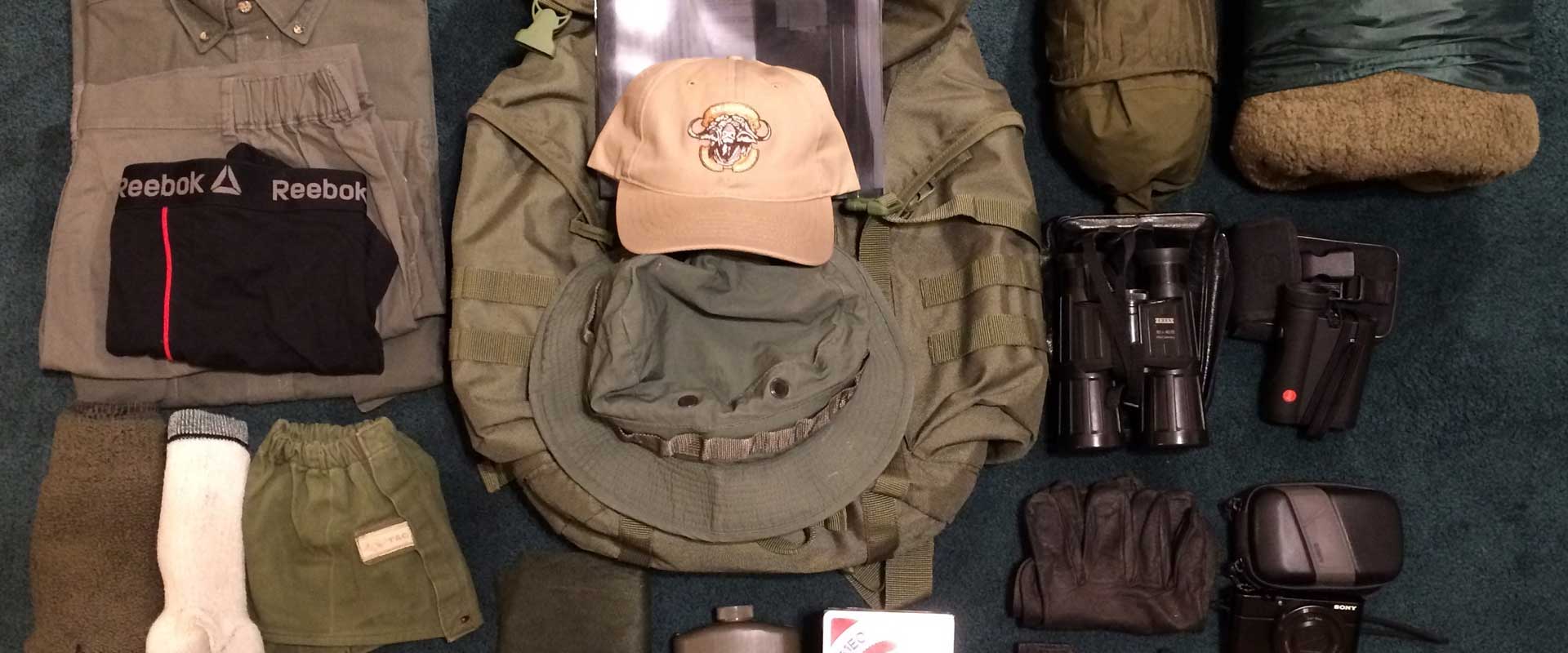
What To Take On Tanzania Safari
What To Take On Tanzania Safari
Packing for a safari is somewhat different to other trips you have taken. Navigating rural roads in a four-wheel-drive vehicle means that at times you will get covered in dust, so you'll need clothes that hide dirt well. Because temperatures can change dramatically throughout the day, layers are essential (after all, pre-dawn game drives are often chilly even in the height of summer). If your itinerary includes flights in smaller aircraft (between parks) you will need to pack extra light to comply with charter flight baggage restrictions.
Dressing for Your Safari
Safaris are generally casual affairs, and ideal clothes are loose-fitting and lightweight so that they keep you cool and dry. Bring at least one good fleece or jacket to ward off the chill during early morning game drives and evening, when long sleeves and trousers will also help protect you against mosquito bites Pick earthy/khaki-coloured tones for optimum camouflage in the bush.
Clothes and Accessories
- T-shirts
- Several long-sleeve shirts
- A sweatshirt or fleece
- A lightweight raincoat
- Comfortable shorts
- Comfortable trousers
- Cotton or sweat-resistant socks
- Quick-dry underwear (you can easily wash and dry overnight)
- Pyjamas or light T-shirts to sleep in
- UV protective sunglasses
- Safari Sunhat
- Swimsuit/ swimming trunks
- A pair of lightweight, durable walking shoes
- A pair of hiking boots
- Money belt
- A laundry bag to separate your dirty clothes from your clean clothes, in your suitcase.
- Ladies – include a decent sports bra is essential for Africa’s bumpy roads.
WHAT TO TAKE IF YOU ARE MOUNTAIN CLIMBING:
Footwear – Boots
A pair of good Goretex trekking boots. Some people recommend leather. Leather is much heavier but often more waterproof.
Boots need to be waterproof and breathable, very comfortable, and worn in before you climb to avoid blisters and sore feet – so buy your boots well in advance
Make sure your boots are big enough to accommodate the extra pair(s) of socks you'll be wearing during summit night or wear a lighter pair of boots at a lower altitude, with a pair of bigger sized boots (with extra padding and room for thicker thermal socks for summiting).
Tight boots compromise circulation and your feet will freeze.
Also, make sure your boots support your ankles - especially during your descent.
Take at least 4 pairs of thick, thermal socks for higher altitudes and a dozen thinner/normal socks. If your feet tend to sweat you will need several fresh pairs per day (and always carry a spare pair in your day pack). Sweat causes blisters so make sure you always wear dry socks. Keeping your feet in good condition is vital to a successful climb.
Outer Clothing Layers
Good Rain protection is essential. Once your gear is wet you have little hope of drying it again.
Warm feet/hands and dry layers of clothes are essential for a successful climb and, your number of layers will increase as you gain altitude.
Layers of clothing keep you far warmer than one thick layer, through body warmth naturally trapped between layers. You will need more layers as you gain altitude. Layers will keep the wind out and maintain warmth.
Your outer jacket layer should be high-quality breathable material, and big enough to go over all your other layers on ‘summit night’. A weatherproof jacket with a fitted, attachable fleece for inside is ideal, in addition to a thick sweatshirt on top of several, breathable T-shirts against your skin. The wind factor and below zero temperatures are often foolishly underestimated at mountainously high altitudes - on the equator!
You will need rain protection covering your day pack and your main haversack, which will be carried by porters. Either get an outer cover that is elasticized and fits securely over your packs.
Sound Advice
Only climb with quality operators who will ensure that your gear is protected from moisture.
A ‘downy jacket’ is ideal. Not only for the ‘summit night’ but also when sitting around at dinner time when your body is not generating heat through movement. It can be expensive though and if you'll never need it again and you can't hire one, then a few warm fleeces will do the job - provided you wear a windbreaker on the outside.
Fleeces provide a lot of warmth for little weight. Two or even three thinner ones are better than one single thick fleece, not only because you can better adjust your clothing according to the temperature, but because the air between clothing layers provides better insulation and warmth. Wearing many layers is the key to staying warm on Kilimanjaro.
Water Resistant Pants: Invest in quality trekking pants that are wind-resistant, and water-resistant (not quite waterproof but it takes heavy rain before it soaks in) and they also repel dirt. They weigh next to nothing and are very comfortable to wear. Many designs allow you to unzip the legs and wear the pants as shorts. Two pairs will suffice, however, make sure they are big enough to comfortably wear over several thermal under layers.
Thermal Under Layers: have two functions. They insulate against cold and draw moisture away from the body (they are breathable or ‘wicking’). By wicking sweat away from the body, your base layer keeps you dry, comfortable, and chill free. Thermal base layers will also help to keep you warm by trapping an insulating layer of warm air against your skin. Base layers can be made of several materials including synthetics (Polyester or Polypropelene) or Merino wool - but beware, that the wicking effect only works if ALL the layers you wear do it. Most good fleeces are breathable and your rainwear should also be.
The Key to Staying Warm on Kilimanjaro: is wearing many layers, so bring three pairs of thermal long johns and long-sleeved thermal tops. Use one pair to trek in, one bone dry pair to sleep in and a spare emergency pair to wear on summit night.
Gloves & Woolly Hat or Balaclava: will protect your face from freezing wind and sunburn from strong/ high altitude ultraviolet sun rays. Good gloves are vital. Your fingers don't move much clutching your walking poles but will be exposed to the elements. A thermal pair underneath and a water and windproof pair over the top is ideal.
Hand Warmers: These oxygen-activated sachets are cheap, take up no room and weigh nothing. The good ones stay warm for 12 to 16 hours and they are a bliss to have. You can use them while clutching your walking poles. Just shove them inside your gloves. Carry several packets and make sure you test one before purchasing half a dozen or so. The cheaper Chinese brands are ineffectual!
Light T-Shirts or Collared Shirts & a Cap: You might want some light shirts for your time in the humid rainforest. Sunburn don't only happen on the summit, it is recommended you wear collared shirts, and use a cap with a neck protector for the back of your neck, or a light soft scarf you can wear loosely around your neck. Slap on generous amounts of sunscreen on the back of your neck exposed shoulders, arms, face and legs.
Sunglasses: choose good quality, wrap-around glasses or glasses with side protection – to prevent snow blindness, which is a temporary state but very painful, and it can damage your eyes.
Toiletries on the Mountain:
Keep is simple, but ensure you have everything you need to enjoy your climb.
- Toothbrush, toothpaste
- A small bar of soap
- Deodorant (use non-perfumed options)
- A mini bath towel
- Altitude can play havoc with women’s’ monthly cycles, so bring sanitary products
- Water purification tablets
- Antihistamine tablets
- Personal toiletries, including moisturizer
- Sunscreen (minimum SPF 30+)
- Antiseptic gel (for washing your hands when there's no water around)
- Antihistamines for bug bites and allergic reactions
- Mosquito repellant (the most effective includes DEET)
- Your Malaria pill prescription (if needed)
- Your preferred painkillers, e.g., aspirin or Tylenol
- Prescription medicines
- Diarrhoea medication, e.g. loperamide
- Antiseptic cream
- Band-aids
- After-sun cream
A good-sized packet of special ‘Blister Plasters. These hydrocolloid gel plasters treat blisters, and is made of elastomer, which ensures that the plaster stays on skine ven while moving and the polyurethane film prevents blister from worsening and helps new skin to grow beneath the plaster. They are an absolute must and may well save your climb. Feet blisters can be excruciating on a mountain hike and may bring an impromptu end to you reaching ‘The Rooftop of Africa’
Take a spare pair of reading glasses for those that wear contact lenses (it's often too dusty to wear them comfortably)
Other Kilimanjaro Equipment:
Walking Poles: (they will protect your knees on the way down).
A Head Torch (with long lasting batteries, plus a spare pare) is essential during summit night and comes in handy around camp. Take enough batteries and keep them warm on summit night as batteries tend to die in the cold.
Water Bottles/ Containers: for three litres per day. Two litres is the absolute minimum. 2 platypus type water bladders/camel backs water containers for the summit hike. Worn amongst your layers, your water won't freeze as you ascend, and can work as an extra barrier against the wind. These containers have an insulated line to suck water up, leaving your hands unexposed and, it makes it easy to drink as you walk. If you do get a camelback make sure it is fully insulated, including the tubing. Also, make sure that during the summit night you ALWYAS blow the water back into the bladder or it will freeze in the tube and mouthpiece. Don’t use hot water, but warm water is a good way to start.
Add a metal/aluminium water bottle to your list as well, which can double up as a hot water bottle at night. (All water on Kilimanjaro needs to be boiled for drinking, and your team should boil a big tub every night to fill all bottles). Wrap any damp clothing that you want to dry around the bottle and shove it in the bottom of your sleeping bag before you get in - and your clothes will be dry in the morning.
Pack For a Purpose
Many safari camps and lodges now support local community initiatives in and around the wildlife parks, reserves and concession areas. If you want to make a positive difference during your time on safari, ask if you can bring any supplies that will help these projects. Usually school supplies (such as textbooks, pens, pencils and rubbers), basic medication or clothing are helpful.
Final Tips
Before you start packing, make sure to research your options carefully. If there are two parts to your trip, you may be able to pack a separate duffel or backpack for the safari section and leave your main suitcase with us or the hotel back at base. This keeps things light for your safari, climb and beach in Zanzibar.
Need a more customised exprience?
We will make it happen.
Arusha Office:
- Phone: +255 784 162 038
- Email: info@faceafricaadventures.com
- Address: Moivo Olorein Ppf, Block 668 Agm Street Arusha Tz, 23100
USA Office:
- Skype: raydigiacomojr
- Email: sales@faceafricaadventures.com
- Address: Laguna Beach, California,
Enquiry Now
"We love hearing from you.So if you have any comments,questions,queries,or you just want to say hello,please get in touch with us".



.avif)

